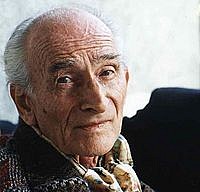BIOGRAPHY

1908-2001
Balthasar Klossowski (or K?ossowski) de Rola, best known as Balthus, was an esteemed but controversial Polish-French modern artist. Appreciated for many years by only a handful of collectors, and ostensibly out of step with the modern movement, Balthus’s classically inspired work won the recognition and admiration of a wider public only late in his career. Although he received no formal training, he came from a highly artistic family background. His father, Erich Klossowski (1875–1949), was a painter and art historian, born to an aristocratic family in East Prussia and the author of a book on Daumier; his brother, pierre Klossowski, was to become a painter and writer; and his mother, Elizabeth Spiro, was also a painter.
After living in Berlin from 1921 to 1924, Balthus returned to Paris; there he studied Old Master paintings in the Louvre, particularly those of Poussin. In 1926 he went to Tuscany to study the frescoes of Piero della Francesca. Apart from a cycle of religious paintings in tempera (1927) for the church of Beatenberg, near Interlaken, his earliest works are Parisian scenes, which betray influences not only from Old Masters but also from his friends Bonnard and André Derain.
In April 1934 Balthus exhibited a group of erotic paintings, including Cathy Dressing (1933; Paris, Pompidou), based on illustrations he had done in 1933 for Emily Brontë’s Wuthering Heights, and the Guitar Lesson (1934). Their unusual character and overt sexuality, allied to the fact that Loeb was then representing the Surrealists, and that the exhibition was enthusiastically reviewed by Antonin. During this period he also established himself as an outstanding portrait painter with penetrating studies of andré Derain (1936) and Miró and his Daughter Dolores(1937–8), while continuing to explore a troubling eroticism in pictures of childhood and puberty such as The Children (1937) Thérèse Dreaming (1938) and The Salon (1941–3).
In the mid-1930s Balthus returned to his earlier interest in landscape, notably in The Mountain (Summer) (1937; New York, Met.), his largest work to date. Conceived in homage to Poussin, and especially Courbet, this represents memories of the mountainous terrain near Berne in which he had lived as a child and to which he was to return in 1977. His interest in landscape was further confirmed when he took refuge from the war at Champrovent in Savoie and matured after his move c. 1954–5 to the château de Chassy in the romantic Morvan mountains in Burgundy. The period at Chassy is distinguished by a marked lightening of the palette, dryness of the paint surface, occasionally mannered systematic brushwork and conspicuous lack of depth, as in Large Landscape with Trees (the Triangular Field) (1955).
In 1950, while still living in Paris, he began studies for two paintings that rank as masterpieces: The Room (1952–4) and Passage du Commerce-St-André (1952–4). The claustrophobic atmosphere of the former, full of intrigue and anxiety, could be taken as an illustration of Artaud’s concept of the Theatre of Cruelty, although in mood it is also reminiscent of Henry Füseli. The other is a companion piece to his earlier painting The Street. Taking as its setting a pedestrian alley near where Balthus lived in Paris (his studio was in the Cour de Rohan near the Odéon), it is also an allegory of the ages of man, and a comment on history, particularly on the French Revolutionary events with which this street was closely associated.
In 1961 André Malraux, then French Minister of Culture, appointed Balthus as Director of the Académie de France in the Villa Medici, Rome, where he remained until 1977. This brought about an abrupt change of direction in his work, as his energies became directed by his taste for the theatre and for history. He supervised the restoration of the Villa Medici, rediscovering ancient frescoes, and replanted the gardens in their old splendour. His few paintings from this period, such as the Turkish Room (1966), and some from later years, as in the Painter and his Model (1981), are set in and around the villa. They betray a final influence, that of Japanese art, confirmed by a trip to Japan in 1962, where he met his second wife.
